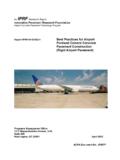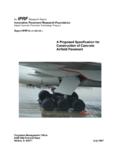Transcription of Supplemental Report for Proposed Specification for ...
1 An IPRF Research Report Innovative Pavement Research Foundation Airport concrete Pavement Technology Program Report IPRF-01-G-002-04-1A Supplemental Report for Proposed Specification for Construction of concrete Airfield Pavement Programs Management Office 5420 Old Orchard Road Skokie, IL 60077 July 2007 An IPRF Research Report Innovative Pavement Research Foundation Airport concrete Pavement Technology Program Report IPRF-01-G-002-04-1A Supplemental Report for Proposed Specification for Construction of concrete Airfield Pavement Principal Investigators Dr.
2 Shiraz Tayabji, , CTLG roup Dr. John Anderson, , Tigerbrain Engineering, Inc. Contributing Authors Mr. Hassan Barzegar, Mr. Gary Fick Mr. Earl Butch F. Gowder, Mr. Jim M. Shilstone, Dr. Peter C. Taylor, Ms. Marie Torres Programs Management Office 5420 Old Orchard Road Skokie, IL 60077 July 2007 i PREFACE This Report has been prepared by the Innovative Pavement Research Foundation (IPRF) under the Airport concrete Pavement Technology Program.
3 Funding is provided by the Federal Aviation Administration (FAA) under Cooperative Agreement Number 01-G-002-04-1. Dr. Satish Agrawal is the Manager of the FAA Airport Technology R&D Branch and the Technical Manager of the Cooperative Agreement. Mr. Jim Lafrenz is the IPRF Cooperative Agreement Program Manager. The IPRF and the FAA thank the Technical Panel that willingly gave of their expertise and time for the development of this Report . They were responsible for the oversight and the technical direction. The names of those individuals on the Technical Panel follow.
4 David Cross, National Association of State Aviation Officials Michael J. DeVoy, , Armstrong and Associates Richard Donovan, , Army Corps of Engineers Starr Kohn, , , Soil and Materials Engineers, Inc. Jeff Rapol, Federal Aviation Administration John Rothnie, Port of Seattle Mike Shayeson, The Harper Company ACKNOWLEDGEMENTS The project team would like to acknowledge the contributions by the staff of the following: Federal Aviation Administration Transportation Systems Center, Army Corps of Engineers The project team would also like to acknowledge that the Proposed Specification incorporates the collective experience of a broad range of experts who have, over the years, contributed so much to the developments in airport concrete pavement construction technology.
5 As a result of their contributions, which have produced long lasting concrete pavements, the United States enjoys one of the best aviation systems in the world. The contents of this Report reflect the views of the authors, who are responsible for the facts and the accuracy of the data presented. The contents do not necessarily reflect the official views and policies of the Federal Aviation Administration. This Report does not constitute a standard, Specification , or regulation. ii EXECUTIVE SUMMARY The Standards for Specifying Construction of Airports, FAA Advisory Circular: AC 150/5370-10B incorporates Item P-501 portland cement concrete Pavement.
6 Airport concrete pavement project funded under the federal airport improvement program (AIP) are typically developed in accordance with the requirements contained in Item P-501 and sometimes in conjunction with specific project requirements and local practices related to material availability and regional concerns, and as approved by the FAA. The current version of Item P-501, released in 1989 and since modified several times, provides guidance on the following: 1. concrete materials (including composition and materials requirements) 2. Construction methods (including equipment, concrete placement, finishing, jointing, curing, and sealing) 3.
7 Method of acceptance (including sampling and testing) 4. Contractor quality control 5. Basis for payment Since the early 1990 s, significant changes have taken place in concrete technology as well as concrete pavement construction technology. Although Item P-501 has been modified several times, many of the changes and new concepts have not been formally incorporated in the Specification . As part of a recent IPRF study, a Proposed Specification for concrete airfield pavement has been developed for possible adoption by the FAA. The Proposed Specification places emphasis on the need to produce a durable end product, that is, a durable concrete pavement.
8 The product requirements that are specified are a combination of prescriptive requirements for certain materials as well as end product requirements for the as-delivered concrete and for the as-placed concrete . There is less emphasis on the means and methods to produce the end product. This should allow the contractor reasonable flexibility to use innovative construction methods and equipment that will result in cost savings to owner agencies without sacrificing the quality of the product. Specifically, the Proposed Specification will allow constructors to identify sources of variability in the airfield concrete pavement construction process and to minimize the variability; thus delivering an end product that is consistent and durable.
9 The Proposed Specification intent is to: 1. Inspire creativity and maintain a standard for the evaluation of the construction 2. Incorporate a system of measurement consistent with acceptance criteria that will validate the design parameters 3. Encourage innovation and be "results-oriented" 4. Result in a product of the highest quality and consistent with the available local materials. The key items of the Proposed Specification are listed below: 1. Emphasis on end product requirements for the concrete and the concrete pavement. iii 2. Denoting aggregates as a generic material and not as coarse and fine aggregates.
10 3. Requirement to optimize the combined aggregate gradation which results in a dense concrete matrix that has the attributes needed for workability and long-term durability. 4. Requirement of a plan for mitigation of reactive aggregates. 5. Allowing use of splitting tensile strength testing for concrete strength acceptance. 6. No prescriptive requirements of paving equipment. 7. Construction of a test section to demonstrate and validate the Contractor s concrete production and concrete placement processes. 8. Requiring a Weather Management Plan, as applicable, for larger projects.



